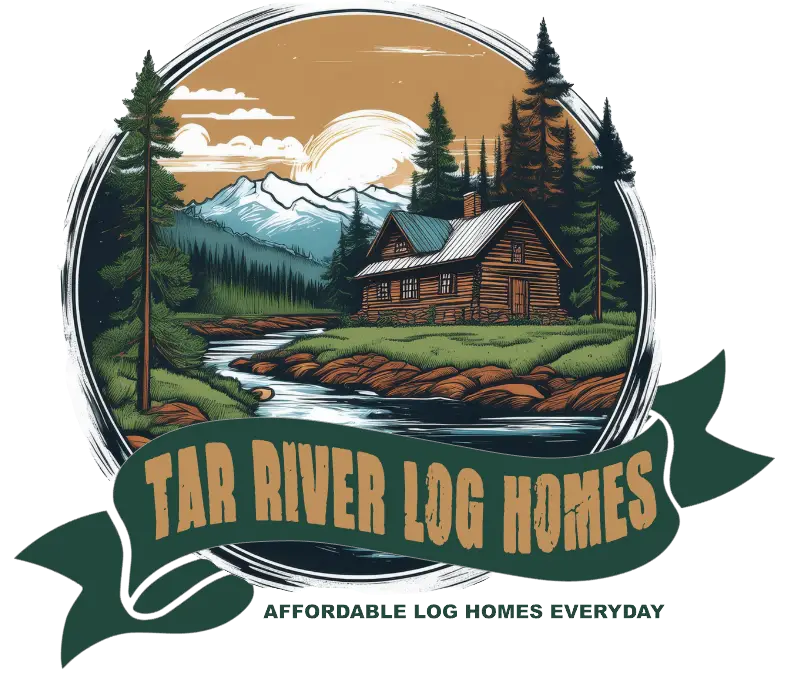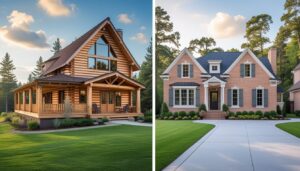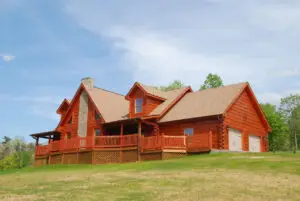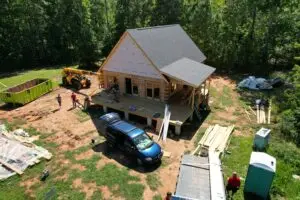When you’re choosing between a log home and a traditional home, it’s not just about price. It’s about lifestyle, comfort, and how the home will serve your family for years to come.
Log homes bring a rustic feel, natural insulation, and long-term value. Traditional homes lean toward flexibility, faster builds, and lower upkeep. Each option has benefits that appeal to different needs and budgets.
At Tar River Log Homes, we believe building your dream shouldn’t be complicated or overpriced. That’s why we provide straightforward log home packages that keep quality high and costs clear.
This guide breaks down the differences—materials, design, costs, and more—so you can decide which type of home fits you best.
Key Differences Between Log Homes and Traditional Homes
When you put log homes and traditional homes side by side, you’ll spot clear contrasts in materials, building methods, and overall vibe. These things shape your costs, upkeep, and the way your home feels every day.
Construction Materials
Log homes use whole logs—usually pine or cedar—stacked to form the walls. These logs come straight from forests, thick and sturdy, and they insulate well. Each log home carries its own quirks: knots, grain, and a sense of individuality.
Traditional homes rely on wood frames covered with drywall, brick, or vinyl siding. These lighter materials are easier to swap out if something goes wrong. Instead of full logs, you’re looking at processed lumber and factory-made parts.
The logs are kiln-dried and precision-cut for a snug fit, boosting durability and energy efficiency without tacking on extra insulation.
Building Methods
Building a log home means stacking and sealing logs with care—no shortcuts. The logs settle and shift over time, so builders leave space for that natural movement. It’s a slower, more skilled process, especially if you want hand-cut or custom logs.
Traditional homes go up with the frame-and-stick method. Builders set up a skeleton of studs, then add insulation, walls, and the roof. This method is quicker and more standardized, so it’s easier to find materials and labor.
Many log homes come as kits, with everything pre-cut and labeled. Many log home suppliers offer this approach, which saves money and reduces surprises.
Appearance and Aesthetics
Log homes stand out with their rugged, natural look—perfect for woodsy or rural settings. The thick logs, visible grain, and chunky corners give off a warm, inviting vibe.
Traditional homes can swing from colonial to ultra-modern, depending on the materials and finishes. You’ll see cleaner lines and smoother surfaces, but sometimes less of that “one with nature” feeling.
A log home can feel like it grew out of the landscape, blending naturally with its surroundings. Prefer a polished, classic, or sleek look? Traditional construction probably fits better.
Design and Architecture
Log homes and traditional homes differ in structure and how much you can tweak the design. Both can fit your needs, but the way you customize and build them isn’t quite the same.
Structural Design
Log homes stack big, solid logs horizontally. Those logs are the frame and the exterior, so you get insulation built right in. Structural Design — The log’s thickness and type, such as Eastern White Pine, impact strength, and efficiency.
Traditional homes use a wood or steel frame, then cover it with brick, siding, or drywall. This goes up faster and makes it easier to experiment with different styles. But you’ll need to add insulation to get the same comfort.
Customization Options
With log homes, your choices revolve around log style and floor plan. You pick the log diameter, corner type, and stain color. You can customize your plan—open spaces, cozy nooks, whatever suits you. The log structure means some details will always look a bit different than a drywall house.
Traditional homes open up a wider menu of exterior and interior options—rooflines, windows, room layouts, decorative flourishes. But sometimes, building codes or budgets put a cap on how wild you can get.
Cost Comparison
The price tag matters; no way around it. You’ll want to know what you’ll shell out up front and what the home holds in value down the road.
Initial Construction Costs
Log homes can cost more at the start, mostly because thick logs like Eastern White Pine need custom cutting and proper drying. Skilled labor pushes the price up, too. Some suppliers offer wholesale rates on logs, which helps keep costs reasonable.
Traditional homes often use cheaper, mass-produced materials—think drywall and standard lumber—so the initial price is lower. Still, if you’re after a well-built, custom log cabin, the price gap isn’t as wide as you’d think.
You might pay 10-20% more for a log home than a typical frame house, but you get solid, lasting walls in return.
Long-Term Value
Log homes insulate well and stand up to the years. The logs hold heat, so you’ll likely spend less on energy, especially in cold weather. If you keep up with maintenance, log homes can even gain value because of their unique look and tough construction.
Traditional homes have steadier maintenance costs, but cheaper materials might mean more repairs—think repainting or re-siding every so often. Over time, those costs can add up, sometimes closing the gap with log homes.
Working with a trusted supplier means you get solid value without hidden fees.
Energy Efficiency and Insulation
How your home uses energy depends a lot on its bones. The materials and building style shape your heating and cooling bills. Good insulation and the right building tricks can keep your costs down.
Thermal Performance
Log homes use thick wood that stores heat during the day and releases it at night. That keeps things steady inside. Wood is a natural insulator, and solid logs do a decent job compared to standard framing.
Traditional homes depend on added insulation—fiberglass, foam, you name it. If it’s not installed right, you’ll get cold spots and drafts. Logs breathe and handle moisture shifts well, which can make things comfier. But the quality of the logs, their thickness, and tight seams really matter.
Heating and Cooling Needs
Logs soak up heat and let it out slowly, so a log home might need less heating in winter. In summer, the thick walls help keep things cool, sometimes without blasting the AC.
Traditional homes can be easier to seal up tight, which helps with cooling if your insulation and windows are up to snuff. Some log suppliers offer wood balancing thermal performance and cost, eliminating the need to choose between comfort and budget.
Durability and Maintenance
Your pick—log or traditional—changes how your house faces the elements and what kind of upkeep you’ll deal with. Both can last, but the work involved isn’t quite the same.
Weather Resistance
Thick logs in log homes stand up to wind and rain, acting as natural barriers. They’re tough in storms, especially when built with good wood like Eastern White Pine. But if you skip sealing, logs can soak up moisture and develop cracks or rot.
Traditional homes use frame walls and siding—vinyl or brick—to keep water out. These layers resist moisture well but can dent or crack from hard knocks.
Both types need solid roofing and drainage to stay dry. For logs, sealing is key. For siding, regular checks keep trouble at bay.
Ongoing Care Requirements
Log homes need sealing and staining every few years to protect against sun, bugs, and rain. You’ll want to check for gaps or cracks and patch them fast.
Traditional homes usually need less frequent attention. Painting or siding repairs come every 7–10 years. You still have to watch for mold or pests, but it’s often easier to spot and fix issues on framed walls.
If you like things to last, knowing the care routine helps you plan your time and money. Quality logs and proper guidance can make maintenance less of a headache.
Environmental Impact
Choosing log or traditional means thinking about your impact on the planet. Materials and building style both shape how much energy and waste your home creates.
Sustainability of Materials
Log homes use real wood, often from trees grown for building. If the wood comes from managed forests, it’s a renewable resource. Eastern White Pine grows quickly and can be harvested responsibly.
Traditional homes lean on concrete, brick, and steel—materials that use more energy and are harder to recycle. Wood in log homes stores carbon, which lowers greenhouse gases. But you’ve got to make sure the wood is treated and sourced right.
Eco-Friendly Construction Practices
Building a log home usually means less waste. You get pre-cut logs and kits ready to go, so there’s not much scrap. Dry, kiln-treated wood keeps your home lasting longer with fewer repairs.
Traditional homes need more insulation and extra materials to hit the same energy efficiency as a log home. Many log home builders keep things simple and direct, which saves both waste and energy. That’s good for your budget and the planet.
Lifestyle and Comfort
How you live inside your home matters—a lot. Air quality, noise, and comfort all shift depending on your home’s style. Each type brings its own perks that shape daily life.
Indoor Air Quality
Log homes often have better air because the wood naturally balances moisture. That helps stop mold and keeps the air fresh. Logs absorb and release moisture, so your home doesn’t get too stuffy or too dry.
Traditional homes use drywall and synthetic materials, which can trap dust and allergens. Without good ventilation, the air can turn stale.
If you have allergies or breathing issues, a log home built with solid logs might help. Still, you’ll want decent ventilation and filters, whatever you choose.
Noise Levels
Thick log walls block outside noise better than most traditional walls. So if you’re near a busy road or noisy neighbors, a log home can feel like a quiet retreat. Traditional homes use thinner walls, and sound can sneak through.
You can add soundproofing, but it’s another step. A log home’s solid log walls provide natural quiet—no extra effort needed. You might just find it easier to unwind, away from the daily racket.
Insurance Considerations
Insurance companies sometimes treat log homes differently from traditional homes. Since logs are solid wood, insurers may see them as higher fire risks, which can raise premiums. Traditional homes, with drywall and siding, are often cheaper to insure.
The National Association of Home Builders recommends comparing policies before committing to a build, since insurance costs can vary widely by location.
Resale Value and Market Trends
When you talk about resale value, traditional homes usually hold steady because they appeal to a broader group of buyers. Most folks are familiar with brick or wood-frame houses, so these homes tend to move faster in most markets.
Log homes might bring in a higher price if a buyer values the natural, cozy vibe. Still, the market for log homes is smaller. It can take some patience to find a buyer who truly appreciates the style and craftsmanship.
Let’s break down a few market points:
| Factor | Traditional Home | Log Home |
| Buyer Interest | Wide range | More niche, specific buyers |
| Maintenance Concerns | Familiar upkeep | Requires unique care |
| Value Appreciation | Steady, predictable growth | It can be higher if well kept |
Local trends make a big difference. In certain areas, log homes are popular for vacation spots or rural retreats, so prices stay strong. But in cities or suburbs? Traditional homes usually have the edge.
If you build with a trusted company, you get affordable, decent-quality materials. That helps you get into the log home market without overspending, which could mean better resale returns down the road.
Of course, your home’s condition and location usually matter more than the building style itself.
Choosing the Right Home for You
Picking between a log home and a traditional home really depends on what you care about most. If you want natural beauty, energy efficiency, and that warm, inviting feel, a log home might be your thing. Traditional homes often offer more design options and are easier to find in established neighborhoods.
Budget matters, too. Log homes can cost less if you buy materials wholesale, like from Tar River Log Homes. Traditional homes might have lower upfront material costs, but sometimes they need more maintenance as the years go by.
Here’s a quick side-by-side:
| Feature | Log Home | Traditional Home |
| Material Costs | Often lower with direct suppliers | Varies, sometimes higher |
| Maintenance | Needs upkeep to prevent wear | Regular but different types |
| Energy Efficiency | Natural insulation with logs | Depends on the materials used |
| Style Flexibility | Rustic, natural look | Wide range, modern to classic |
You want a house that fits your lifestyle. If you like DIY projects or want to customize things, starting with a log home kit gives you a lot of control. Prefer something move-in ready or easier to finance? A traditional home might be the way to go.
Don’t forget to think about your local climate and land. Logs hold heat well in cold weather but need a little extra care in humid areas. Traditional homes might handle certain climates better.
Take your time weighing these points. Your needs and budget should drive the decision—not just the style.
Ready to take the next step? Explore our log home packages and see how simple building your dream cabin can be.
Frequently Asked Questions
Choosing between a log home and a traditional home? You’ll want to consider costs, upkeep, and how each fits your lifestyle. Let’s get into the details.
What are the pros and cons of living in a log home compared to a traditional home?
Log homes offer natural beauty and great insulation, which can save you money on heating and cooling. That rustic look? Hard to beat.
But log homes do need more care. You’ll have to keep an eye out for moisture, insects, and settling over the years. Traditional homes usually come with less of that kind of upkeep.
How does the cost of building a log home compare with that of a traditional stick-built house?
Building a log home can cost more upfront because of the quality wood and special construction.
That said, you might save money down the line with energy efficiency. Tar River Log Homes offers affordable kits to help keep those costs in check.
What are some common disadvantages of owning a log home?
Log homes need regular sealing and staining to protect the wood. Pests like termites or carpenter ants can be a headache, too. Traditional homes don’t usually face these issues as much.
Is it more difficult to sell a log home than a traditional home?
Sometimes, yeah. Log homes attract a smaller group of buyers. Some folks worry about maintenance or insurance. Still, the right buyer will see the charm and warmth that a log home offers.
Why might insurance companies be hesitant to insure log homes?
Insurance companies see log homes as a higher fire risk since they’re made of wood. Plus, repairs or replacements can cost more because the materials are unique. That can make insurance premiums higher or just tougher to get.
Do log homes typically have better structural integrity than traditional homes?
Log homes get their strength from those hefty, solid log walls. When builders use quality materials—like what Tar River Log Homes offers—they can really hold their own against wind and weather. Still, it all comes down to how well the place gets put together.




